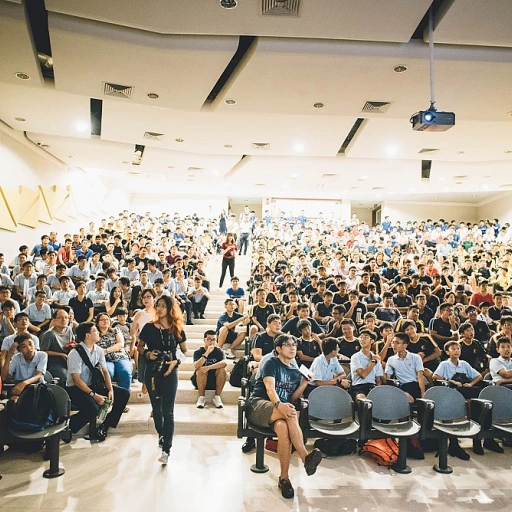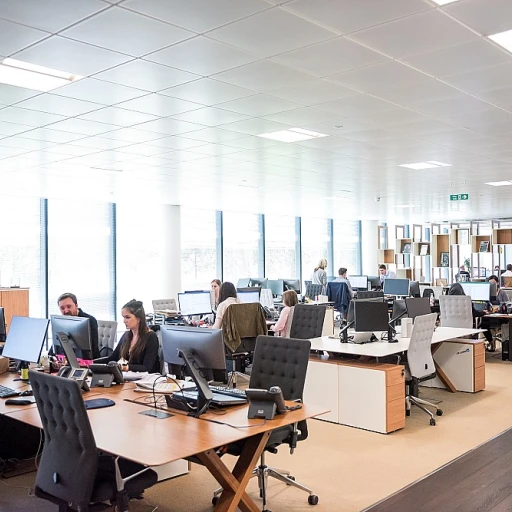
Understanding the Importance of Candidate Screening
The Foundation of a Successful Hiring Process
In the realm of human resources, candidate screening is a pivotal step in the hiring process. It serves as the foundation upon which successful hiring decisions are built. The importance of candidate screening cannot be overstated, as it helps organizations identify the right fit for their teams, ensuring that the selected candidates align with the company's values and goals.
Effective screening is not just about filling positions quickly; it's about finding the top talent that will contribute positively to the organization's growth. Over the years, the methods and tools used in screening have evolved, incorporating advanced technologies and data-driven insights to enhance accuracy and efficiency.
Organizations must consider various factors when developing their screening processes. These include the screening methods employed, the types of questions asked, and the criteria used to evaluate candidates. A robust screening process can help mitigate the risk of hiring unsuitable candidates, which can be costly both in terms of time and resources.
Moreover, the screening process must be adaptable to different roles and industries. Whether you're hiring for a technical position requiring specific hardware skills or a customer-facing role where interpersonal skills are paramount, the screening process should be customized to meet these needs.
For those interested in delving deeper into the strategic aspects of candidate screening, exploring the power of talent mapping can provide valuable insights into aligning talent acquisition with organizational objectives.
Key Elements of a Robust Screening Process
Building a Solid Foundation for Screening
Effective candidate screening is fundamental in filling the right positions with the top talent. Over the years, organizations have come to realize that a well-structured screening process is an invaluable tool. It ensures that they hire candidates who not only fit the job requirements but also align with the company culture. To build this foundation, the integration of standard procedures is crucial. Start by defining the roles and responsibilities clearly. This step helps in drafting custom questions that target the specific skills and competencies necessary for the job. Using a well-thought-out panel for interviews can also ensure diversity in perspectives and reduce hiring biases. Here are a few key elements that strengthen the screening process:- Detailed Job Descriptions: Crafting comprehensive job descriptions sets the stage for effective candidate screening. It minimizes misunderstandings about the role, thus attracting the right candidates.
- Pre-screening Assessments: Incorporating assessments can help screen high-risk candidates early, saving time during later stages. These assessments can be as simple as a skills test or more complex such as personality profiling.
- Behavioral Interviews: Implementing a behavioral interview technique provides insights into how a candidate has handled situations in the past, which is indicative of future behavior.
- Consistent Evaluation Criteria: By establishing a set standard for evaluations, companies can maintain objectivity and ensure that all candidates are assessed on an equal footing.
Leveraging Technology in Screening
Utilizing Advanced Technology for Efficient Screening Processes
Embracing technology has revolutionized candidate screening by enhancing precision in evaluating applications and saving valuable time for HR professionals. The integration of sophisticated systems can cater to a wide range of tools, from custom screens and panel systems to automated software and digital assessment platforms. This technological shift allows organizations to prioritize critical aspects like screening methods and top screening, ensuring a high success rate in selecting qualified candidates. Whether using screen systems that apply advanced filters to parse applications efficiently or deploying streamlined methods that optimize the screening process, technology can substantially alleviate the burden of manual review. This is particularly beneficial for screening larger applicant pools, where each resume might contain precise questions or customizable fields that help identify top talent effortlessly. Furthermore, incorporating artificial intelligence in screening methods can provide a level of accuracy and reliability that traditional screens might lack. This includes identifying high risk candidates who may not meet the standard requirements, thus saving resources and ensuring that only the cream of the crop makes it to the next stage. For those eager to explore advanced screening processes further, integrating a comprehensive competency checklist could be the key to elevating your screening system beyond traditional methods. It serves as a framework for evaluating candidates under different contexts, thereby improving the quality of hires and setting a precedent for future recruitment practices. While these technologies offer great promise, they must be assessed for their compatibility with existing infrastructure, such as hardware capabilities and software compatibility. HR professionals should be mindful of cost implications, comparing factors like price and free shipping options for software solutions, and factor in any necessary privacy policies. Ultimately, leveraging technology in candidate screening processes not only sets a benchmark for recruitment standards but empowers organizations to make data-driven decisions, optimizing human resources operations for years to come.Common Challenges in Candidate Screening
Overcoming the Hurdles of Candidate Screening
The journey of candidate screening is not without its obstacles. Many organizations find themselves tangled in a web of challenges that can impact the effectiveness and efficiency of their efforts. Identifying these common hurdles is the first step toward a smoother process.- Volume Overload: One of the primary challenges is the sheer volume of applications. With the rise of digital platforms, a single job post can fill the inbox with hundreds, if not thousands, of resumes. This influx of candidates makes it difficult to identify the top screening candidates without a structured approach.
- Time Constraints: Speed is of the essence in today’s fast-paced market. However, balancing thorough screening with timely response is a delicate act. Rushed decisions can lead to overlooking qualified candidates, especially when screening methods aren't optimized.
- Screening Bias: Unconscious biases can creep into the screening process, affecting the impartiality of candidate selection. For instance, studies show that certain names or demographic indicators may inadvertently influence the screening system.
- Inconsistent Questioning: Without a standard set of custom questions, the screening process can become inconsistent. Tailoring questions to specific roles and ensuring uniformity across candidates can help mitigate this issue.
- Technological Limitations: Outdated hardware and software can hinder efficient screening. Investing in top screens or panels can make the review process smoother, ensuring that no detail is missed.
- Regulatory Compliance: Navigating privacy policy and ensuring rights reserved compliance adds another layer of complexity. Staying informed about such regulations is imperative to avoid high-risk decisions.
Best Practices for Top Screening
Best Approaches to Enhance Your Candidate Screening
When refining your candidate screening process, several best practices emerge from years of experience in human resources. Adhering to these can streamline operations and help fill positions more efficiently.
- Define Clear Criteria: Establish clear, custom criteria for each role, considering both standard requirements and specific job needs. This provides clarity in main content and helps focus on the most relevant candidates.
- Utilize Structured Interviews: Implement screening methods like structured interview questions to ensure fairness and consistency. This can help you assess candidates objectively and improve the quality of hiring.
- Incorporate Technology: Utilize AI and other technologies to automate initial screening processes. This can save valuable time and reduce costs associated with the initial stages of screening. Keep an eye on evolving hardware prices, as they may impact your budget.
- Emphasize Candidate Experience: Ensure a smooth application and screening process for candidates, respecting their time and effort. A cumbersome process may lead to high-risk candidates opting out early.
- Transparent Communication: Maintain clear and timely communications, including responses about next steps. Avoid leaving candidates in the dark, akin to waiting outside for a screen door to open.
- Periodic Review and Improvement: Regularly review your screening system and methods, adjust panel interviews or screening tools as needed to address evolving job market trends and company needs.
By integrating these practices, companies can manage their screening processes effectively, ensuring they choose the top screens for roles while maintaining a strong, positive brand presence in the recruitment market. As you refine your strategies, these tips will prove invaluable, much like a well-fitted porch screen against a summer breeze.
Future Trends in Candidate Screening
Embracing Tomorrow's Screening Developments
Keeping pace with future trends in candidate screening emerges as a critical requirement for HR professionals. To stay relevant and effective, being adaptable and receptive to innovations is key.- Advanced AI and Machine Learning: Leveraging technology for smarter candidate screening is no longer just a buzzword. Over the years, AI has evolved to provide sophisticated tools that can dissect resumes, analyze custom questions, and predict the fit through screening methods with precision. This trend is expected to continue, offering both opportunities and challenges for screen systems.
- DEI Focused Screening: Diversity, equity, and inclusion are paramount. Future trends indicate more emphasis on screening processes that eliminate biases in screening, an effort to welcome all, from different colour panels, backgrounds, and experiences to fostering women health and redefining black and white standards.
- Virtual and Remote Screening: With the rise of remote work, virtual porch screening with top screens tools has become standard. Companies are now investing in user-friendly hardware and software solutions that allow for effective remote evaluations, making the screening door more accessible than ever.
- Enhanced Data Privacy: As privacy policies become stringent, ensuring data protection during candidate screening will be a top priority. Organizations need to implement measures to safeguard information, fostering trust and compliance, while respecting the rights reserved by candidates.
- Feedback-Centric Approach: Soliciting feedback through screening reviews from candidates post-screening can guide improvements. This feedback loop encourages transparency, helping firms optimize and fill any gaps, ultimately leading to effective candidate screening processes.
- Cross-Functional Screening Panels: Future trends also point to the adoption of interdisciplinary screening panels, where professionals from various departments, like windows doors and screen porch companies, participate in the assessment. This enhances the comprehensiveness and balance of decisions.












